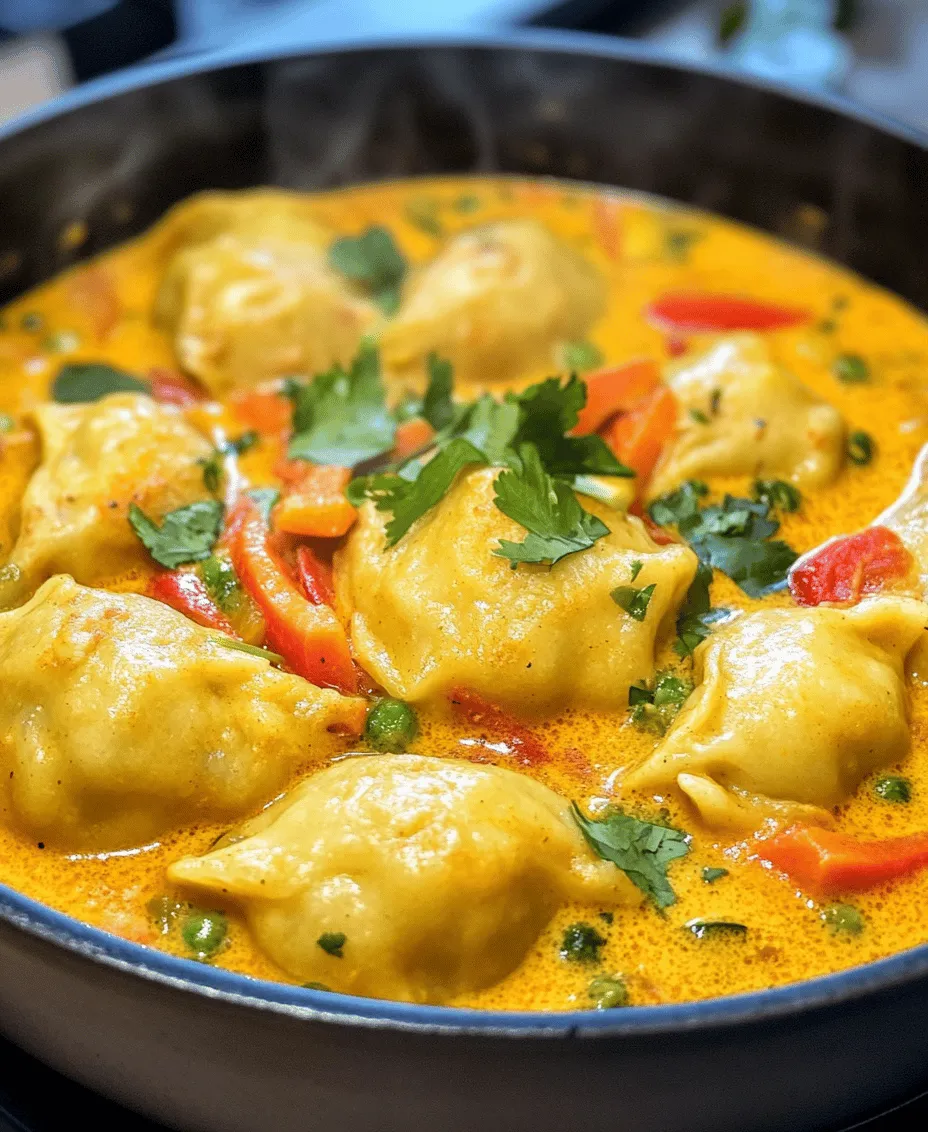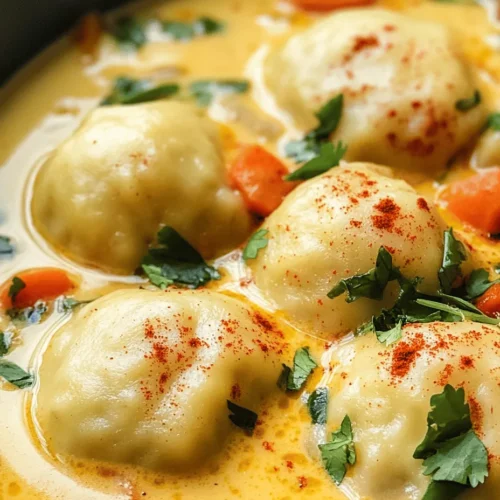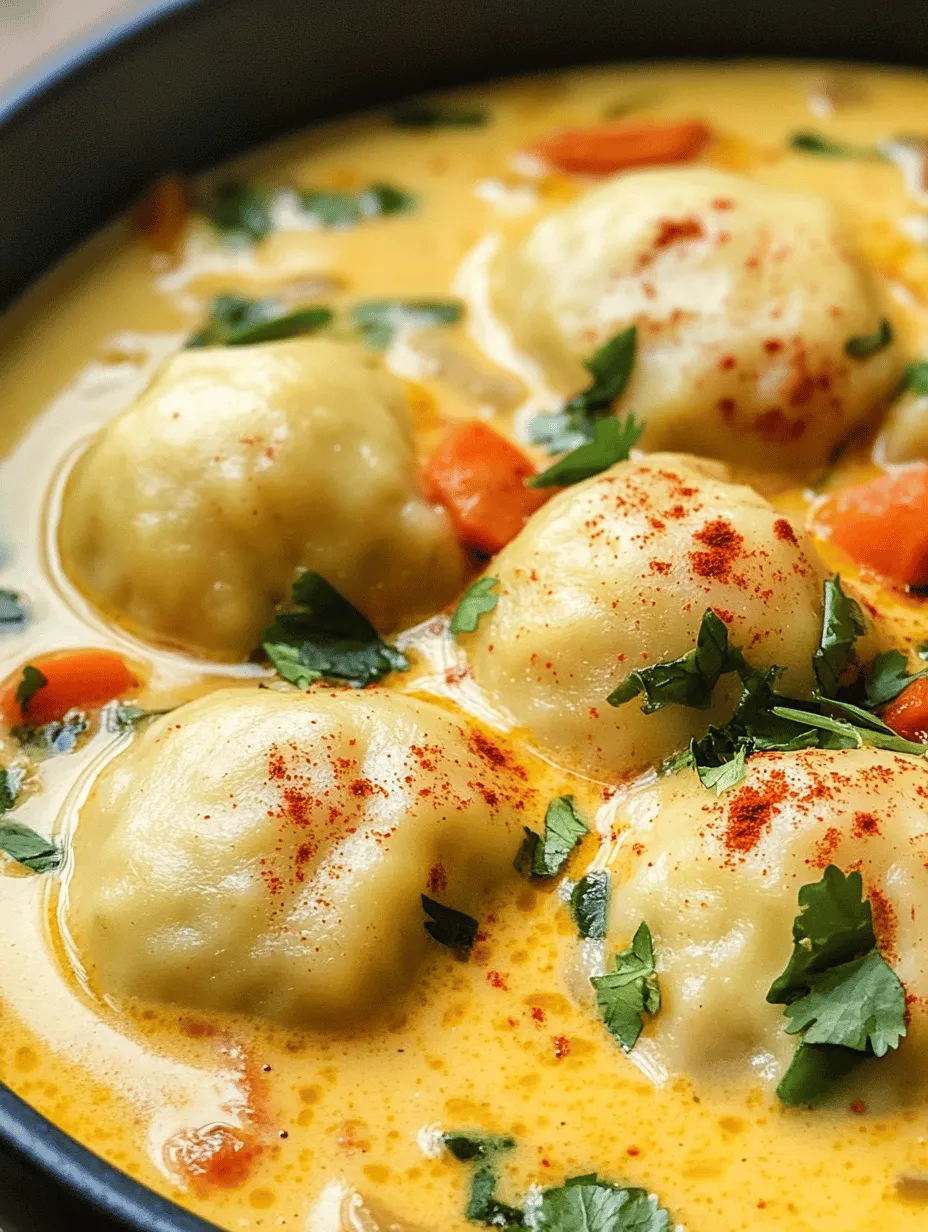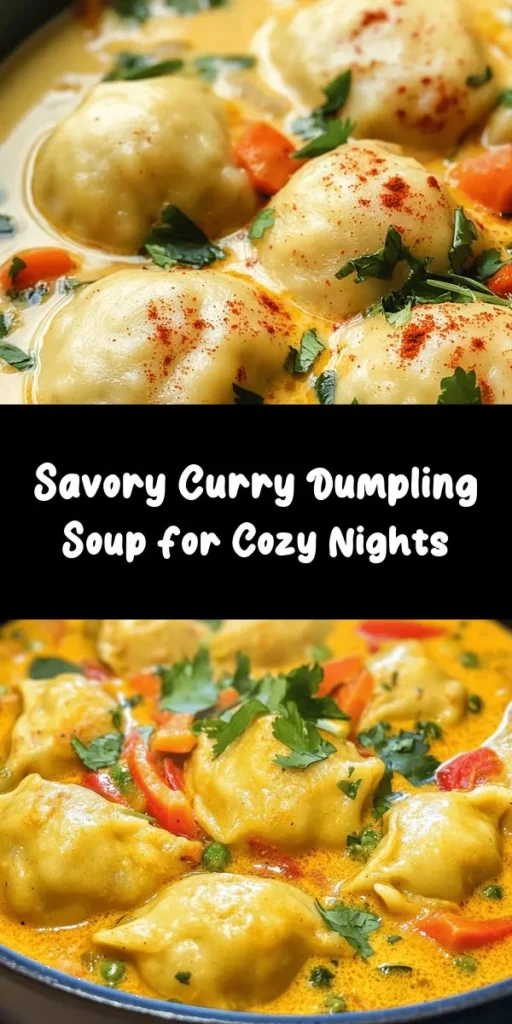Introduction
Curry dumpling soup is a culinary gem that beautifully marries the comforting nature of dumplings with the rich, aromatic qualities of curry. This dish is not only a feast for the taste buds but also a visual delight, showcasing vibrant colors and textures that appeal to both the eyes and the palate. The fusion of flavors in this soup makes it a standout dish, whether enjoyed on a chilly evening or as a comforting meal any day of the week.
One of the most appealing aspects of curry dumpling soup is its versatility. The dumplings can be filled with a variety of ingredients, allowing for endless customization. Meanwhile, the curry broth, infused with spices and coconut milk, brings warmth and depth to the dish that is nothing short of irresistible. With the right balance of spices, each spoonful offers a warming hug that leaves you feeling nourished and satisfied.
Beyond its deliciousness, this soup is packed with health benefits. The combination of fresh vegetables, spices, and protein provides a wealth of nutrients. Turmeric, a key spice in curry, is known for its anti-inflammatory properties, while ginger adds a zesty kick and supports digestive health. Whether you choose tofu or chicken as your protein source, both options contribute essential amino acids to your meal, making this soup not only comforting but also nourishing.
Dumplings hold a significant place in many cultures around the world. From Chinese jiaozi to Italian ravioli, they are a beloved staple that reflects the culinary traditions of various regions. In this recipe, we embrace the universal love for dumplings while infusing it with the exotic flavors of curry, creating a dish that pays homage to both tradition and innovation.
Understanding the Ingredients
Understanding the ingredients that go into your curry dumpling soup is key to achieving the best flavors and textures. Each component plays a vital role, contributing to the overall success of the dish. Here’s a closer look at the essential ingredients you’ll need.
All-Purpose Flour
All-purpose flour is the backbone of your dumpling dough. It provides the structure needed to create soft, pliable dumplings that hold their shape during cooking. The gluten in the flour allows for elasticity, ensuring that your dumplings won’t fall apart when boiled. When making the dough, it’s important to use the right amount of water to achieve a smooth, workable consistency. Too much water can make the dough sticky, while too little can result in dry dumplings.
Turmeric and Ginger
Turmeric and ginger are two spices that not only elevate the flavor profile of your curry soup but also bring a host of health benefits. Turmeric is renowned for its anti-inflammatory properties, thanks to its active compound, curcumin. This spice adds a warm, earthy flavor and a vibrant yellow color to the broth. Ginger, with its sharp, peppery taste, aids in digestion and adds a refreshing zest to the soup. Together, these spices create a harmonious balance that enhances the overall flavor of your dish.
Vegetables
The vegetables you choose to include in your dumpling soup can vary widely, but they should always be fresh and nutritious. Common options include carrots, bell peppers, and spinach, which not only add color but also provide essential vitamins and minerals. Carrots, for instance, are rich in beta-carotene, while bell peppers are high in vitamin C. Incorporating a variety of vegetables not only boosts the nutritional value of the soup but also adds layers of flavor and texture that make each bite exciting.
Tofu vs. Chicken
When it comes to the protein component of your dumplings, you have the option to use either tofu or chicken. For those following a vegetarian or vegan diet, tofu serves as an excellent source of plant-based protein. It’s important to choose firm or extra-firm tofu for the best texture in your dumplings. On the other hand, chicken provides a rich flavor and is a great choice for meat-eaters. You can use ground chicken or finely chopped pieces, depending on your preference. Both options can be seasoned and sautéed with spices to enhance their flavor before being added to the dumpling filling.
Coconut Milk
Coconut milk is a crucial ingredient in creating a creamy, luscious curry broth. Its rich and smooth texture adds a delightful creaminess that balances the spices in the curry. Additionally, coconut milk is dairy-free, making it suitable for those with lactose intolerance. Beyond its flavor, coconut milk is also a source of healthy fats, which can help improve heart health and provide sustained energy. When adding coconut milk to your soup, be sure to stir it in after the spices have been cooked to allow the flavors to meld beautifully.
Red Curry Paste
Red curry paste is the star of the show when it comes to flavoring your soup. This aromatic blend of spices typically includes red chilies, garlic, lemongrass, and shallots, providing a complex depth of flavor that is both spicy and fragrant. The level of heat can vary depending on the brand of curry paste you use, so it’s wise to start with a smaller amount and adjust according to your taste preference. The red curry paste not only infuses the broth with flavor but also contributes to the vibrant color of the soup.
Step-by-Step Guide to Making Best Curry Dumpling Soup
Preparing the Dumpling Dough
The foundation of any good dumpling is the dough, and achieving the right consistency is crucial. Begin by combining all-purpose flour and a pinch of salt in a large mixing bowl. Gradually add warm water, mixing with your hands or a wooden spoon until the dough begins to come together. The goal is to create a smooth and elastic dough that is not too sticky.
Once the dough has formed, knead it on a lightly floured surface for about 5-10 minutes. This process is essential for developing gluten, which gives the dumplings their structure. You want the dough to feel soft yet firm, with a slight spring when pressed. After kneading, cover the dough with a damp cloth and allow it to rest for at least 30 minutes. This resting period helps relax the gluten, making it easier to roll out and shape the dumplings.
Crafting the Perfect Dumpling Filling
While the dough is resting, it’s time to prepare the filling. Start by sautéing your chosen vegetables and protein in a bit of oil over medium heat. This step is crucial as it softens the vegetables and enhances their flavors. Feel free to experiment with different combinations of vegetables such as mushrooms, cabbage, or green onions for added flavor and texture.
Once the vegetables are tender, add in your protein and continue to cook until it is fully cooked through. For tofu, ensure it is well-seasoned and has a nice golden color. If using chicken, make sure it is cooked until no longer pink inside. After everything is cooked, season the mixture with salt, pepper, and a splash of soy sauce or sesame oil for an umami kick. Let the filling cool before using it to fill your dumplings.
Forming and Cooking the Dumplings
Now that your dough and filling are ready, it’s time to shape the dumplings. Start by dividing the dough into small portions, rolling each piece into a ball about the size of a golf ball. On a floured surface, roll out each ball into a thin circle, aiming for a diameter of about 3 inches. The thinner you roll the dough, the more delicate your dumplings will be.
Place a small spoonful of filling in the center of each dough circle. Carefully fold the dough over the filling to create a half-moon shape, making sure to pinch the edges tightly to seal the dumpling. You can also create pleats along the edge for a traditional look, but this step is optional.
Once all your dumplings are formed, you have several cooking methods to choose from. You can boil, steam, or pan-fry them. Boiling is the simplest method: just drop the dumplings into a pot of boiling salted water and cook until they float to the surface, which usually takes about 3-5 minutes. For pan-frying, heat a bit of oil in a skillet, add the dumplings, and fry until the bottoms are golden brown before adding a splash of water and covering to steam them through.
Creating the Flavorful Curry Soup Base
With your dumplings ready, it’s time to create the soup base. In a large pot, heat some oil over medium heat, then add minced garlic and shallots. Sauté until fragrant, then stir in your red curry paste, allowing it to cook for a minute to release its essential oils. Next, pour in your coconut milk and vegetable or chicken broth, stirring well to combine.
You can then add your choice of vegetables, such as chopped carrots, bell peppers, or leafy greens, letting them simmer until tender. Season the soup with salt, and adjust the spice level if needed. For an extra kick, you can add a splash of lime juice or a sprinkle of fresh cilantro once the soup is ready.
This flavorful broth will serve as the perfect backdrop for your delicious dumplings, allowing the spices and ingredients to meld together beautifully.
In the next part of the article, we will explore the final steps to complete your Best Curry Dumpling Soup, as well as tips for serving and storing this delightful dish.

Combining the Broth and Coconut Milk
To create the rich and creamy base of your Best Curry Dumpling Soup, the next step involves combining your prepared broth with coconut milk. Begin by bringing your broth to a gentle simmer in a large pot. Once the broth is warm, slowly pour in the coconut milk, stirring consistently to ensure a seamless blend. The coconut milk not only adds a velvety texture but also balances the spices while infusing the soup with a subtle sweetness.
As you mix the two, take a moment to appreciate how the flavors begin to meld. The creamy coconut milk softens the intensity of the curry paste and adds depth to the overall dish. This harmonious integration of ingredients exemplifies the beauty of cooking; it transforms individual elements into a cohesive and flavorful whole.
Discussion on the Balance of Flavors
Flavor balance is paramount in any great soup, especially in a dish as dynamic as curry dumpling soup. The interplay of spicy, sweet, sour, and salty notes creates a complex flavor profile that keeps each spoonful exciting. As you taste the soup, consider the specific flavors at play. If the broth feels too spicy for your palate, you may want to add a bit more coconut milk to temper the heat. Conversely, if the soup lacks a kick, a little extra red curry paste can elevate it.
The balance of flavors can also be adjusted by incorporating various herbs and spices. Fresh herbs like basil or mint can add a refreshing quality, while a touch of soy sauce or fish sauce can enhance umami depth. Remember, the goal is to create a medley of flavors that complement rather than overpower each other, making each bite a delightful experience.
Tips for Adjusting Spice Levels with Red Curry Paste
When using red curry paste, it’s essential to gauge its potency, as different brands can vary widely in heat. For those who prefer milder flavors, start with a smaller amount—about one tablespoon—and gradually increase until you reach your desired spice level. Remember, you can always add more, but it’s challenging to tone down the heat once it’s in the pot.
To further manage the spice, consider the order of your ingredients. Adding vegetables like carrots or bell peppers can absorb some heat and contribute sweetness, creating a more balanced dish. Additionally, if the soup becomes too spicy, a splash of coconut milk can provide relief, cooling down the overall flavor.
The Role of Acidity and Sweetness
In many culinary traditions, acidity and sweetness are crucial for achieving a well-rounded dish. In the context of your curry dumpling soup, lime juice and brown sugar serve as essential components that enhance the soup’s depth. The acidity from lime juice brightens the flavors, while the brown sugar adds a layer of complexity and rounds out the spice.
After your soup has simmered for a while, squeeze in the juice of one or two limes, tasting as you go to ensure balance. If you feel the soup could benefit from a hint of sweetness, add a teaspoon of brown sugar. These adjustments will not only enhance the soup’s flavor but also create a more enjoyable culinary experience.
Suggestions for Balancing Flavors Based on Personal Preference
Achieving the perfect balance of flavors is subjective and can vary widely based on personal preferences. To cater to your taste, consider the following adjustments:
– For a sweeter soup: Increase the amount of brown sugar or add more coconut milk.
– For an extra kick: Add more red curry paste or a pinch of cayenne pepper.
– For a tangy flavor: Incorporate additional lime juice or even a splash of vinegar.
Experimenting with these elements will allow you to customize the soup to your liking, ensuring that each bowl reflects your unique palate.
Cooking the Dumplings in the Soup
Now that your soup base is perfectly balanced, it’s time to add the dumplings. The key to cooking dumplings in the soup is to do so gently to prevent them from breaking apart. Start by bringing the soup to a gentle simmer before carefully adding the dumplings one by one. Ensure they have enough space to float freely, which will help them cook evenly.
Techniques for Adding Dumplings to the Simmering Soup Safely
Using a slotted spoon, gently lower the dumplings into the broth. This technique helps avoid splashes and keeps the dumplings intact. Once you place them in the soup, resist the urge to stir vigorously. Instead, allow them to cook undisturbed for a few minutes. As they cook, they will rise to the surface, indicating that they are nearing completion.
How to Determine When the Dumplings Are Perfectly Cooked
Dumplings are typically cooked when they float to the surface and have a slightly glossy appearance. Depending on the recipe and size of your dumplings, this can take anywhere from 5 to 10 minutes. To ensure they are fully cooked, you can cut one open to check that the center is hot and firm. Once they are done, remove the pot from heat to prevent overcooking.
Serving Suggestions and Pairings
Presentation can elevate your dining experience, so take a moment to consider how you serve the Best Curry Dumpling Soup. Ladle the soup into bowls, making sure to include a generous helping of dumplings and broth.
Presentation Tips for an Appealing Bowl
To create an appealing presentation, consider layering the ingredients. Start with a base of broth, add the dumplings, and top with vibrant garnishes. A sprinkle of fresh cilantro adds a pop of color, while lime wedges can be placed next to the bowl for a fresh squeeze of juice right before eating.
Suggested Side Dishes or Accompaniments to Enhance the Meal Experience
To complement your soup, consider serving it with a side of jasmine rice or a simple green salad. The rice can soak up the delicious broth, enhancing the overall meal experience. A light salad with a citrus vinaigrette can provide a refreshing contrast to the richness of the soup.
Ideas for Garnishing Beyond Cilantro
While cilantro is a popular garnish, consider expanding your options to elevate the dish even further. Here are some ideas:
– Lime wedges: For a zesty kick.
– Chili flakes: To add heat and a touch of color.
– Thinly sliced green onions: For a mild onion flavor and crunch.
– Chopped peanuts or cashews: For added texture and nuttiness.
Nutritional Analysis of the Dish
As you enjoy your Best Curry Dumpling Soup, it’s helpful to understand its nutritional profile. This dish is not only satisfying but can also be quite nutritious.
Breakdown of Calories, Macronutrients, and Vitamins per Serving
Assuming a serving size of one bowl of soup with three dumplings, the approximate nutritional breakdown is as follows:
– Calories: 350-400
– Protein: 15-20g
– Carbohydrates: 45-50g (depending on dumpling type)
– Fat: 15-20g
– Vitamins: Rich in Vitamin C from lime juice and various vitamins from the vegetables used.
Discussion on the Health Benefits of the Ingredients Used in the Recipe
The ingredients in this recipe offer several health benefits. Coconut milk provides healthy fats, especially medium-chain triglycerides (MCTs), which can support metabolism. The vegetables contribute essential vitamins and minerals, while the spices used in the curry paste may offer anti-inflammatory properties.
How This Dish Fits into Various Diets
This curry dumpling soup can be easily adapted to fit various dietary preferences. For a vegan version, use plant-based dumplings and check that your curry paste is free from fish sauce. If gluten is a concern, opt for gluten-free dumplings or make your own from gluten-free flour. The versatility of this recipe makes it suitable for many dietary needs.
Cultural Variations and Adaptations
Dumpling soups are enjoyed in various cultures, each bringing unique flavors and techniques. For instance, Chinese wonton soup features delicate dumplings filled with pork and shrimp, while Japanese gyoza soup showcases pan-fried dumplings in a flavorful broth.
Overview of Dumpling Soups from Different Cultures
Exploring dumpling soups from around the world can inspire creativity in your own cooking. Consider trying different fillings based on regional cuisines:
– Pierogi: Polish dumplings often filled with potatoes or cheese.
– Momo: Nepali dumplings filled with spiced vegetables or meat.
– Ravioli: Italian dumplings stuffed with cheese or meat, simmered in broth.
Ways to Adapt the Recipe for Different Taste Preferences or Ingredient Availability
Feel free to adapt the dumpling fillings and flavors to suit your taste preferences or ingredient availability. If you have a favorite protein, such as chicken or tofu, incorporate it into the filling. Spice profiles can also be adjusted by adding different herbs or using a different curry paste, such as green or yellow curry.
Suggestions for Alternative Fillings and Spice Profiles
Consider experimenting with fillings such as:
– Spinach and ricotta: For a creamy, cheesy option.
– Mushroom and tofu: For a hearty, plant-based alternative.
– Beef or chicken: For a protein-packed dumpling.
Conclusion
The Best Curry Dumpling Soup is not just a meal; it’s an experience that brings together vibrant flavors, textures, and aromas. The process of making this dish—from balancing flavors to cooking the dumplings—offers a rewarding culinary journey. Whether you are enjoying this soup on a chilly evening or sharing it with loved ones, it provides comfort and satisfaction.
As you explore this recipe, don’t hesitate to experiment with different ingredients and flavors. The versatility of this dish allows for endless creativity in the kitchen. Enjoy the process, and may each bowl of your curry dumpling soup bring warmth and joy to your table.



